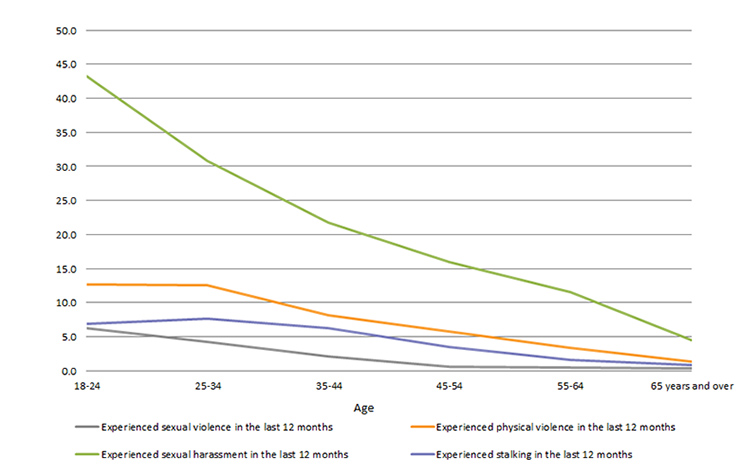Posted 29/11/2018 by Joanne Simon-Davies
The Australian Bureau of Statistics (ABS) has released further results from the 2016 Personal Safety Survey (PSS) which focus on experiences of violence and personal safety of people with disability. This FlagPost provides a summary of these results.
The PSS collected information from men and women aged 18 years and over about the nature and extent of violence experienced since the age of 15. The survey, which was previously conducted in 2005 and 2012, asked persons with disability about their experiences of violence and feelings of safety in the community. These current results focus on experiences in the 12 months prior to the PSS. It is important to note disability status is determined by the respondent’s condition at the time of the survey and does not necessarily indicate whether they had a disability at the time of any violence, stalking or sexual harassment incidents. The 12 month time restriction does, however, increase the likelihood that respondents’ disability status coincided with any incidents.
In addition, proxy interviews (when the person selected for the interview is incapable of answering for themselves due to illness/injury or language difficulties and requires a proxy to answer on their behalf) did not include sensitive content, including experiences of violence. Therefore there is an under-representation in the survey of people with a profound or severe communication disability. Also, PSS is a household survey, so people living in institutions are out of scope.
For the survey, ‘disability or long-term health condition’ is defined as being if a limitation, restriction, impairment, disease or disorder has lasted, or is expected to last for six months or more, which restricts everyday activities. This definition is broad, so the estimate of number of people with disability is higher than in some other ABS publications.
According to the survey, there were a total of 5.8 million people aged 18 years and over with a disability or long-term health condition in Australia in 2016. Of these:
- 330,400 had experienced sexual and or physical violence in the 12 months prior to the survey (1.4 per cent). Of this group:
- 78,700 had experienced sexual violence (23.4 per cent)
- 288,700 had experienced physical violence (87.4 per cent).
It is important to note that, where a person has experienced both sexual and physical violence, they are counted separately for each type of violence they experienced but are counted only once in the aggregated total.
- Of those who had experienced sexual and/or physical abuse (330,400 persons):
- 196,300 had a physical disability
- 132,500 had a psychological disability
- 117,200 had a sight/hearing/speech disability and
- 67,900 had an intellectual disability
- When examining severity of disability, people with more severe levels of impairment were more likely to have experienced violence in the past 12 months. Of people with profound or severe core activity limitation (those who need assistance with self-care, communication or mobility), 7.7 per cent experienced violence in the past 12 months (54,800 people), compared with 4.8 per cent of people with moderate or mild core activity limitation (121,500 people).
- Women with disability or a long-term health condition were somewhat more likely to have experienced violence in the preceding 12 months than women without disability or a long-term health condition (5.9 per cent or 172,800 women with disability or a long-term health condition compared with 4.3 per cent or 274,400 of women without disability or a long-term health condition). In contrast, men with disability or a long-term health condition had similar likelihood to experience violence in the last 12 months (5.6 per cent or 158,100) as men without disability or a long-term health condition (6.2 per cent or 383,200).
- Of the 5.8 million people with a disability or long-term health condition, 859,500 had experienced sexual harassment (14.9 per cent) in the 12 months prior to the survey. Sexual harassment was considered to have occurred when a person experienced or had been subjected to one or more selected behaviours which they found improper or unwanted, which made them feel uncomfortable, and/or were offensive due to their sexual nature.
- In the 12 month prior to the survey, 180,200 people with a disability or a long-term health condition reported experiencing stalking (3.1%).
The following chart shows various experiences of people aged 18 years and over with a disability or long-term health condition by age group.

The survey also asks about perceptions of general safety. Both the proportion of people with disability or a long-term health condition who used public transport alone after dark and the proportion who felt safe doing so in the last 12 months increased from 2012 to 2016. However, people with disability or a long-term health condition in 2016 were less likely than people without disability to have used public transport alone after dark in the previous 12 months (25.3% compared with 37.8%).
The information collected through the PSS informs policy and programs to address the prevention, detection, and response to violence and harassment experienced by this vulnerable population.
Clients of the Parliamentary Library can request assistance to interpret the statistics or find other relevant data by contacting the Parliamentary Library.